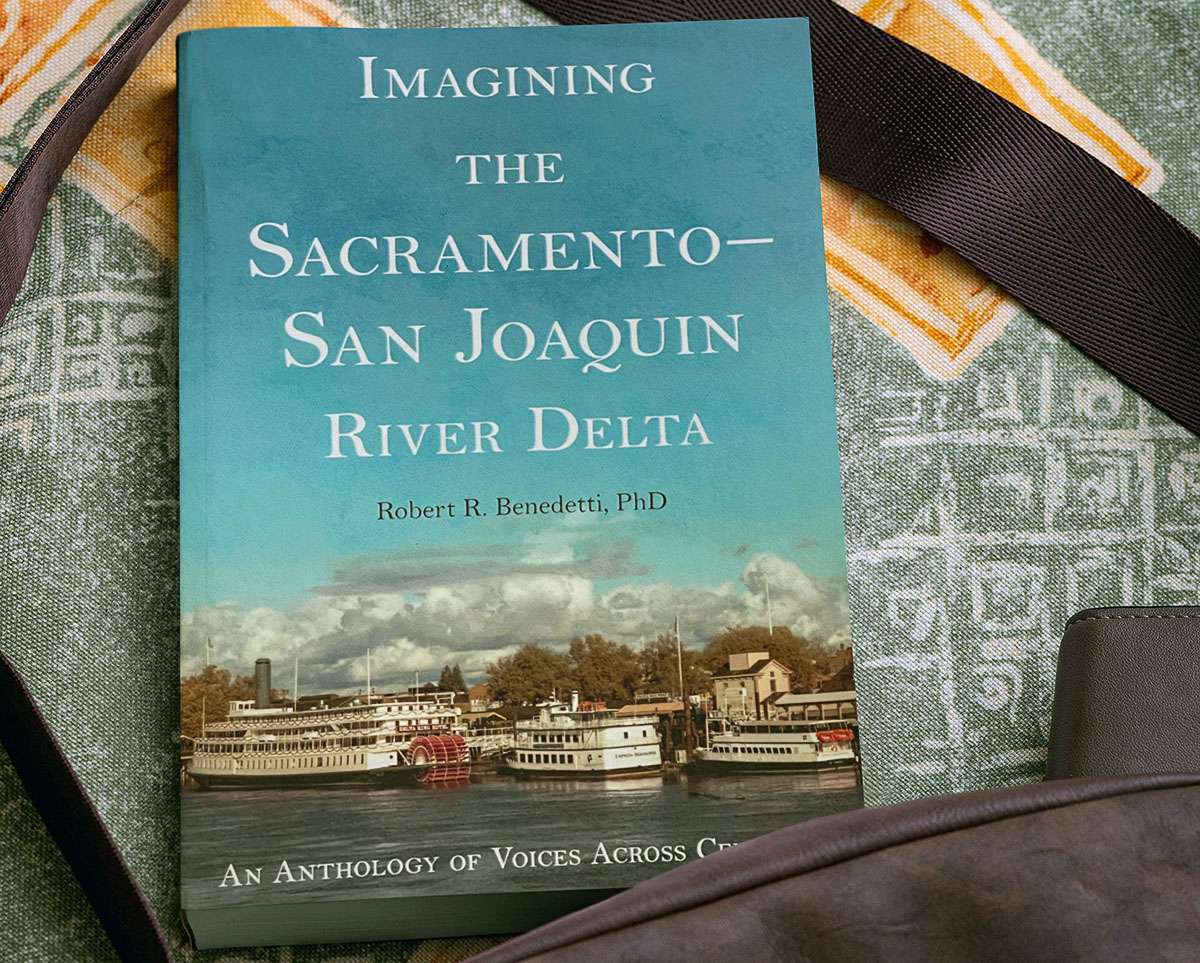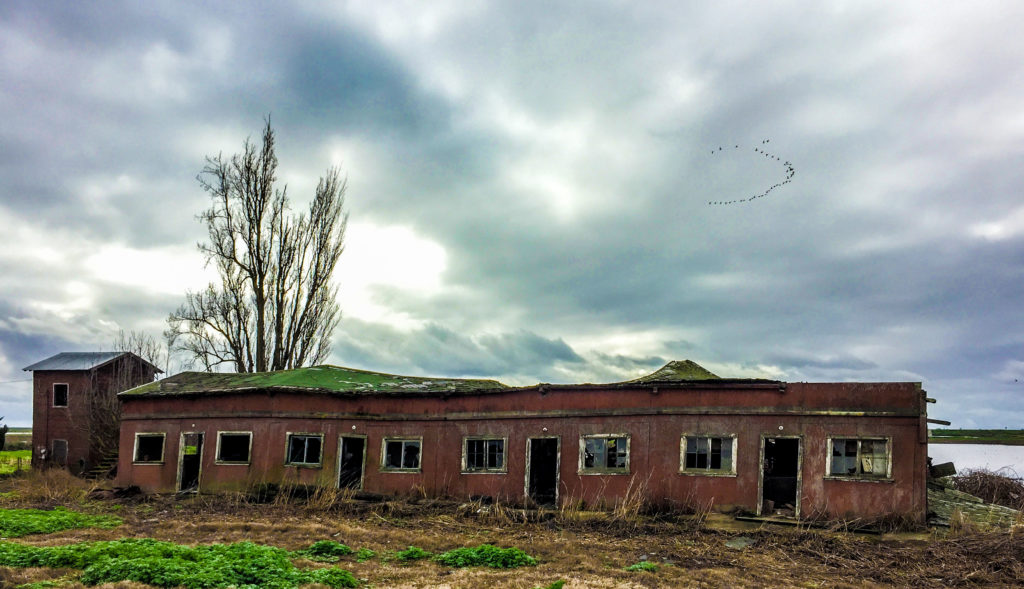Imagining the Sacramento-San Joaquin River Delta
An Anthology of Voices Across Centuries -- book review by David Stuart
- By David Stuart
- Photographs by Rich Turner
- November 22, 2022
- 11:00 pm
- No Comments

Imagining the Sacramento-San Joaquin River Delta:
An Anthology of Voices Across Centuries
by Robert R. Benedetti
381 pages, paperback $34.00
Published by Arcadia Publishing by arrangement with Fonthill Media LLC
Reviewed by David Stuart
How would you describe California’s Delta, where our two great rivers, the Sacramento and the San Joaquin, mingle and linger on their way to the Bays and the Pacific Ocean? Would you tell of a sacred place of creation after a primeval flood? A place of astonishing natural riches?
Would your story speak of a barrier to overland travel between the Bay Area and the plains of the Great Central Valley? Or would you tell of the watery highways that connected the three largest cities in early California: San Francisco, Sacramento City (gateway to the northern Sierra goldfields), and Stockton (the route to the southern placers)?
Would you tell of reclaiming miasmic swamps to yield incredibly productive farmland? Or perhaps of your immigrant ancestors who labored to build the levees or to farm those rich peat soils? Or would you focus on the inventors and entrepreneurs who developed machines to till those lands…and to reduce the need for and cost of those laborers?
Would you reflect on heritage towns in the Delta? On exploring sleepy sloughs in a houseboat? Fishing and waterfowl hunting? Or would the role of our Delta as the kingpin of statewide water engineering first come to mind?

* * *
It is difficult to capture the splendid complexity of the Sacramento-San Joaquin Delta with any one story. That’s why this anthology of writings from multiple viewpoints and eras and addressing diverse topics is so valuable. Dr. Benedetti—who you may know from his years at University of the Pacific or from Renaissance Society programs at Sacramento State University—has done us a great service by masterfully compiling and organizing a host of Delta “voices across centuries.”
As Benedetti points out in the acknowledgments, the foundation of this anthology was the Delta Narratives project, led by Dr. Benedetti and funded by the Delta Protection Commission. That project brought scholars and museum professionals together with Delta residents to explore California’s Delta as not merely a unique geomorphological place, a rich natural habitat, and a critical link in our highly-engineered water system, but also as a place where people have lived and have developed unique lifeways and histories—and continue to do so. The historical and cultural themes developed by the Delta Narratives project are now informing the planning efforts for the Sacramento-San Joaquin Delta National Heritage Area. (As the then-director of the San Joaquin County Historical Society and Museum, I was honored to participate in the Narratives project with our museum archivist, Leigh Johnsen. I now serve on the advisory committee for the National Heritage Area.)
The first chapter of the anthology, “A Native American Paradise,” includes three traditional stories and a moving contemporary poem about the impacts of colonization. It is followed by chapters “Journaling with Spanish Explorations” and “The Rancheros.” The latter chapter has revealing writings on John Marsh and Johann Sutter, plus a memoir from lesser-known early rancher Theodore Cordua, whose Mexican land grant was near modern Yuba City.
In chapter four, “Highway to Gold,” Benedetti serves up an amusing story of life in Benicia; a Bret Harte story about the passing of the torch from the Californios to the Anglos, centered on the landmark Monte del Diablo; and Bayard Taylor’s observations of gold rush era Sacramento and of river travel on the Sacramento River. The chapter concludes with Mark Twain’s reporting of the disastrous explosion of the steamboat Washoe.
“Tensions over the Rivers and the Fertile Lands” includes beautiful descriptions by William Brewer and John Muir and a folksy slice of river life from Jerry MacMullen’s classic Paddle-wheel Days in California. A light-hearted poem, Tall Tales of the Delta, is contrasted with the dark conflicts revealed in Royce’s The Feud of Oakfield Creek, based on the Mussel Slough showdown, and Norris’s The Octopus. The mood circles back with boyhood reminiscences of Freeport by prominent historian Rockwell Hunt.
The somewhat unique challenges that the Delta presented to farmers—and especially the solutions achieved via the development of innovative ag machinery and the entrepreneurial production of such new devices—is covered in the chapter, “Agricultural Technology.” Benedetti gives us good summaries of Stockton’s Benjamin Holt and the development of the Caterpillar tractor, as well as of lesser-known Stocktonian R.G. LeTourneau, the world’s greatest inventor of earthmoving equipment. He includes a wonderful account of the Schmidt brothers “Inventing a Sugar Beet Harvester” and an engaging story that shows the sociological importance of an asparagus cannery in Rio Vista. (I think the second edition of this anthology should add an excerpt from the book The Tule Breakers on the development of the clamshell-bucket dredge and perhaps a writing on the development of the mechanical tomato harvester.)

The contrasting sociopolitical worlds inhabited by “Owners and Laborers” are revealed in excerpts from Richard Dillon’s wonderful Delta Country and Joan Didion’s novel Run River. An engaging story from Jack London’s Tales of the Fish Patrol depicts the tension between commercial salmon fishermen in the Delta and game wardens. Poems on the dehumanization of farm workers and agricultural abundance are followed by powerful narratives about farm laborers from Barrio Boy and from Fat City.

Waves of ethnic, immigrant farm workers shaped the so-called legacy communities of the Delta. The spirit of that “Community Life” is illustrated by some little-known written gems that Dr. Benedetti brings to us: a beautiful story of Portuguese and Japanese neighbors coming together during a flood; reminiscences of a Chinese immigrant to Locke; a coming-of-age and Italian food tradition tale; and a nice account of life in a Filipino labor camp, complete with cross-cultural experiences with the adjacent Japanese community.

Chapter nine on “Prohibition” includes colorful accounts of Locke, Ryde, Foster’s in Rio Vista, and a fictional Benicia-based bootlegging operation. The next chapter on “World War II” has readings on several aspects: the imprisonment of Japanese families; the shortage of agricultural workers and the Bracero Project that addressed that need with imported Mexican workers; and the development of many defense-related facilities in and around the Delta, shielded from seaborne attacks, but accessible by Bay-Delta waterways, railroads, and highways.

Postwar recreational boating experiences in the Delta are addressed in the “Leisure Time” chapter. Excerpts from the ultimate Delta-rat, Hal Schell, and Delta cruiser Erle Stanley Gardner—best known as the author of the Perry Mason novels—capture the offbeat characters, freedom, and tranquility that epitomize recreational boating in California’s Delta.
The next chapter features a compelling excerpt from a novel of which I was not aware: Storm by George Steward (1941, reprinted in 1983 by University of Nebraska Press). It is followed by a selection of poems that reveal aspects of “The River.” I particularly enjoyed Notes Toward the River Itself by beat poet and Locke resident Laura Ulewiecz. Julia Connor’s The Delta Poem is much more challenging, with obscure (to me) references to Biblical and Greco-Roman religious iconography, as she describes the Delta as a pre-modern, almost Hellenistic place. McKinney’s poem Down in the River more-easily evokes the well-known disorientation of tule fog.

Other writings reveal Delta “Fauna,” such as salmon in the poem The King of the San Joaquin by Edward Jones. A longer passage summarizes cooperation between farmers, hunters, and environmentalists to create sustainable wetland waterfowl habitat; it also provides a portrait of farmer, conservationist, and Delta lover Dino Cortopassi.
“The Human/Nature Interface” in the Sacramento-San Joaquin Delta is addressed in poems: San Joaquin by beat poet William Everson/Brother Antoninus; a poem about the Bay-Delta interface by sailor Paula Sheil; poems on ubiquitous Delta bridges by Steven Federle; poems on the joys of fresh fruits and suburban living in Brentwood; and a hard-hitting poem on the tensions inherent to Stockton’s urban-Delta interface.
To conclude the anthology, Dr. Benedetti looks forward in the chapter “Dreams of the Future,” which includes an excerpt from the engaging little book by Jane Wolff: Delta Primer: A Field Guide to the California Delta. Wolff envisions an engineered “wild” space between the region’s urban and agricultural landscapes. In the other selection in this chapter, science fiction writer Ursula Le Guin depicts the calamitous deconstruction of Northern California urban-suburban life resulting in a return to small villages reminiscent of traditional, interconnected Indigenous communities.

* * *
In the introduction to the book, Dr. Benedetti includes a “poem by Leo Briones [that] serves as a prologue for this anthology. It raises many of the themes expressed…and provides a summary of the evolution of a dialogue between the natural endowment of the Sacramento-San Joaquin River Delta and its varied inhabitants” (p. 16). Parts II and III of The Blues in the Delta Breeze, provide the coda for this review:
…10,000 years ago, before the earth last melted,
the Farallones formed the cold coastline of the Pacific
and the Fabled City was but a depression of sand and grass.
Nearly yearlong gusts swept
sand from the sea to the valleys—
as miles and miles of frigid dunes formed far, far inland.
Then slowly
the sun warmed to an epoch
of eternal Spring on California’s north coast.
As the ice melted, the Farallones drifted into a rocky mystery,
the Fabled City became the thumb of the Pacific
and furious salt water chiseled the San Francisco Bay.
Inland
the Sacramento and San Joaquin rivers
roared and merged to form the great Sacramento Delta.
Meandering waterways of slough and marsh,
of sandhill cranes, waterfowl, and raptor.
For thousands of years,
in this resplendent kingdom
of the natural world—bear and elk, deer and beaver,
fox and possum wandered the [tule] fog and peat marshes
in search of Salmon and the tender spouts of Spring.
Then one day
people came,
first Miwok and Yokut
then, it is said, ancient Chinese wanderers.
Land and man lived like a melody,
unbroken timbre of life—
until the settlers arrived; manifest and heartened
leather Forty-Niner and denim farmer.
Slowly they drained the peat marshes
to form islands named after themselves—
Sherman and Brannon, Bethel and Woodward—
then erected levees to make rigid waterways.
Soon in an easterly dash for refuge
the grizzly bear and mule deer
fled to the Sierra Nevada.
The land was plowed and tilled and sowed
to become bread mother of the earth,
rice and alfalfa, walnut and pear.
All along in this Golden State
of innovators and speculators,
of growers and growth merchants—
cities grew and suburbs sprawled.
To fulfill this thirst for prosperity
delta streams were clutched, enchased, transformed—
modern wonders of the world—
great dams named Oroville and Shasta,
quenched massive steel pumps sucking water
to the yearning fields of the mighty San Joaquin Valley
and south to the Shadow Motherland of fortune and modernity—
bear and deer retreated further and further
to the Canaan of the valleys and Jerusalem of the Sierra’s snowy peaks.
###
David Stuart recently retired as the executive director of the San Joaquin County Historical Society. Previously, he directed the Sacramento History Museum, the Sacramento Science Center, and museums in Ventura. His family settled in the Delta in 1860.
- By David Stuart
- Photographs By: Rich Turner
- November 22, 2022
- 11:00 pm
- No Comments

Leave a Reply